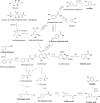Bioprocess Optimization for the Production of Aromatic Compounds With Metabolically Engineered Hosts: Recent Developments and Future Challenges
- PMID: 32154231
- PMCID: PMC7044121
- DOI: 10.3389/fbioe.2020.00096
Bioprocess Optimization for the Production of Aromatic Compounds With Metabolically Engineered Hosts: Recent Developments and Future Challenges
Abstract
The most common route to produce aromatic chemicals - organic compounds containing at least one benzene ring in their structure - is chemical synthesis. These processes, usually starting from an extracted fossil oil molecule such as benzene, toluene, or xylene, are highly environmentally unfriendly due to the use of non-renewable raw materials, high energy consumption and the usual production of toxic by-products. An alternative way to produce aromatic compounds is extraction from plants. These extractions typically have a low yield and a high purification cost. This motivates the search for alternative platforms to produce aromatic compounds through low-cost and environmentally friendly processes. Microorganisms are able to synthesize aromatic amino acids through the shikimate pathway. The construction of microbial cell factories able to produce the desired molecule from renewable feedstock becomes a promising alternative. This review article focuses on the recent advances in microbial production of aromatic products, with a special emphasis on metabolic engineering strategies, as well as bioprocess optimization. The recent combination of these two techniques has resulted in the development of several alternative processes to produce phenylpropanoids, aromatic alcohols, phenolic aldehydes, and others. Chemical species that were unavailable for human consumption due to the high cost and/or high environmental impact of their production, have now become accessible.
Keywords: aromatic compounds; metabolic engineering; microorganisms; process optimization; shikimate pathway; synthetic biology.
Copyright © 2020 Braga and Faria.
Figures


Similar articles
-
Biotechnological production of specialty aromatic and aromatic-derivative compounds.World J Microbiol Biotechnol. 2022 Mar 26;38(5):80. doi: 10.1007/s11274-022-03263-y. World J Microbiol Biotechnol. 2022. PMID: 35338395 Review.
-
Metabolic engineering of microorganisms for production of aromatic compounds.Microb Cell Fact. 2019 Feb 26;18(1):41. doi: 10.1186/s12934-019-1090-4. Microb Cell Fact. 2019. PMID: 30808357 Free PMC article. Review.
-
Recent Advances in Metabolically Engineered Microorganisms for the Production of Aromatic Chemicals Derived From Aromatic Amino Acids.Front Bioeng Biotechnol. 2020 May 5;8:407. doi: 10.3389/fbioe.2020.00407. eCollection 2020. Front Bioeng Biotechnol. 2020. PMID: 32432104 Free PMC article. Review.
-
Biotechnological production of aromatic compounds of the extended shikimate pathway from renewable biomass.J Biotechnol. 2017 Sep 10;257:211-221. doi: 10.1016/j.jbiotec.2016.11.016. Epub 2016 Nov 18. J Biotechnol. 2017. PMID: 27871872 Review.
-
Metabolic engineering strategies for enhanced shikimate biosynthesis: current scenario and future developments.Appl Microbiol Biotechnol. 2018 Sep;102(18):7759-7773. doi: 10.1007/s00253-018-9222-z. Epub 2018 Jul 16. Appl Microbiol Biotechnol. 2018. PMID: 30014168 Review.
Cited by
-
Ferulic acid production by metabolically engineered Escherichia coli.Bioresour Bioprocess. 2021 Aug 10;8(1):70. doi: 10.1186/s40643-021-00423-0. Bioresour Bioprocess. 2021. PMID: 38650224 Free PMC article.
-
Optimization of fermentation conditions and medium components for chrysomycin a production by Streptomyces sp. 891-B6.BMC Microbiol. 2024 Apr 6;24(1):120. doi: 10.1186/s12866-024-03258-9. BMC Microbiol. 2024. PMID: 38582825 Free PMC article.
-
The aminoshikimic acid pathway in bacteria as source of precursors for the synthesis of antibacterial and antiviral compounds.J Ind Microbiol Biotechnol. 2021 Dec 23;48(9-10):kuab053. doi: 10.1093/jimb/kuab053. J Ind Microbiol Biotechnol. 2021. PMID: 34374768 Free PMC article. Review.
-
Metabolic Engineering of Shikimic Acid-Producing Corynebacterium glutamicum From Glucose and Cellobiose Retaining Its Phosphotransferase System Function and Pyruvate Kinase Activities.Front Bioeng Biotechnol. 2020 Sep 10;8:569406. doi: 10.3389/fbioe.2020.569406. eCollection 2020. Front Bioeng Biotechnol. 2020. PMID: 33015020 Free PMC article.
-
Benzenoid Aromatics from Renewable Resources.Chem Rev. 2024 Oct 9;124(19):10701-10876. doi: 10.1021/acs.chemrev.4c00087. Epub 2024 Sep 17. Chem Rev. 2024. PMID: 39288258 Free PMC article. Review.
References
-
- Achnine L., Blancaflor E. B., Rasmussen S., Dixon R. A., Division P. B., Roberts S., et al. (2004). Colocalization of L -Phenylalanine ammonia-lyase and cinnamate 4-Hydroxylase for metabolic channeling in Phenylpropanoid biosynthesis. Plant Cell 16 3098–3109. 10.1105/tpc.104.024406.pathways - DOI - PMC - PubMed
-
- Ahn J. O., Lee H. W., Saha R., Park M. S., Jung J. K., Lee D. Y. (2008). Exploring the effects of carbon sources on the metabolic capacity for shikimic acid production in Escherichia coli using in silico metabolic predictions. J. Microbiol. Biotechnol. 18 1773–1784. 10.4014/jmb.0700.705 - DOI - PubMed
-
- Albertazzi E., Cardillo R., Servi S., Zucchi G. (1994). Biogeneration of 2-phenylethanol and 2-phenylethylacetate important aroma components. Biotechnol. Lett. 16 491–496. 10.1007/BF01023331 - DOI
-
- Averesch N. J. H., Kayser O. (2014). Assessing heterologous E xpression of Hyoscyamine 6-β-Hydroxylase - a feasibility study. Proc. Chem. 13 69–78. 10.1016/j.proche.2014.12.008 - DOI
Publication types
LinkOut - more resources
Full Text Sources
Other Literature Sources

